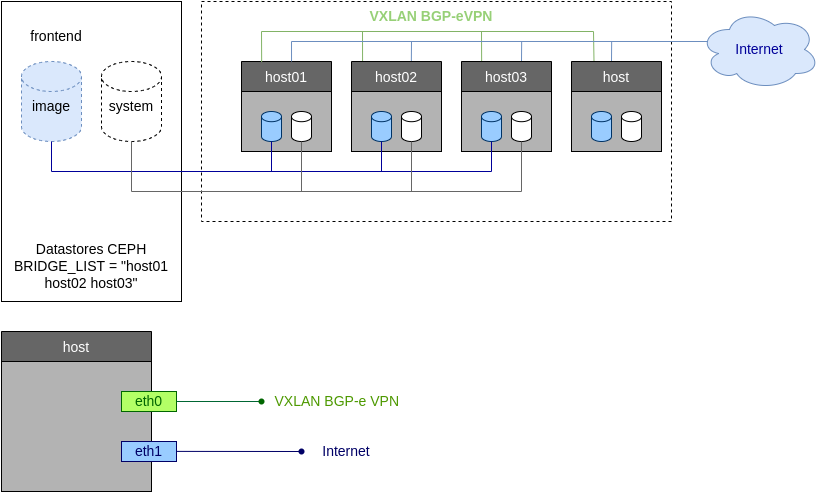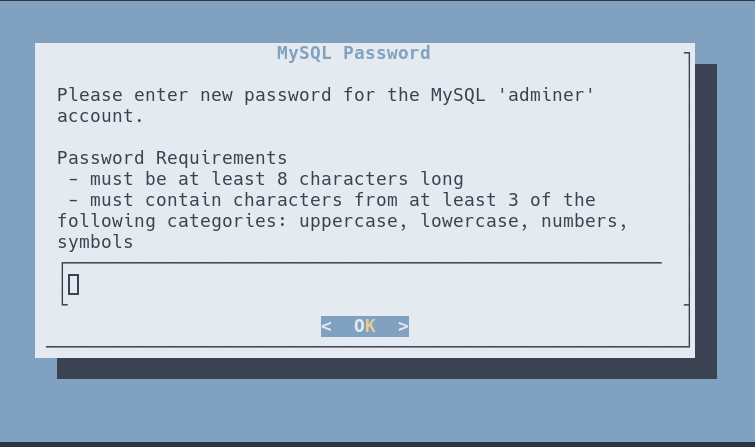On-Premises HCI Cluster¶
On-Premises HCI Implementation¶
An On-Premises Edge Cluster with Ceph consists of a set of hosts with the following requirements:
Host Subsystem |
Configuration & Requirements |
|---|---|
Operating System |
Ubuntu 20.04 Focal installation. |
SSH is configured in the host to grant root passwordless access with the |
|
Networking |
Configured management interface. The OpenNebula front-end can reach the hosts through this network. |
Separated interface connected to the Internet. VMs will access the Internet through this network. Do not configure any IP address for this interface. |
|
Your network should allow inbound connections to ports 22 (TCP), 179 (TCP) and 8472 (UDP) on the management network. The Internet/Public network should not restrict any access. You can later set Security Groups for your VMs. |
|
It’s recomended to use also sperate network interfaces for Ceph |
|
The nodes needs access to Internet (at least while oneprovision runs), to be able to install the dependencies. |
|
Storage |
Hosts should have at least one separate disk for Ceph datastore |
The overall architecture of the On-Premises cluster is shown below. OpenNebula will create for you the following resources:
Image and System datastore for the cluster. The storage is configured to use the Hosts Ceph storage.
Public Network, bound to the Internet interface through a Linux Bridge.
Private Networking, implemented using a VXLAN overlay on the management network.

On-Premises HCI Definition¶
To create a HCI Cluster on-premises you need to input the following information:
Input Name |
Example |
Description |
|---|---|---|
ceph_full_hosts_names |
host01;host02;host02 |
Hosts to run hypervisor, osd and mon ceph daemons (semicolon list of FQDNs or IPs) |
ceph_osd_hosts_names |
(can be empty) |
Hosts to run hypervisor and osd daemons (semicolon list of FQDNs or IPs) |
client_hosts_names |
(can be empty) |
Hosts to run hypervisor and ceph client (semicolon list of FQDNs or IPs) |
ceph_device |
/dev/sdb |
Block devices for Ceph OSD (semicolon separated list) |
ceph_monitor_interface |
eth0 |
Physical device to be used for Ceph |
ceph_public_network |
(can be empty) |
Ceph public network in CIDR notation |
private_phydev |
eth1 |
Physical device to be used for private networking. |
public_phydev |
eth0 |
Physical device to be used for public networking. |
first_public_ip |
172.16.0.2 |
First public IP for the public IPs address range. |
number_public_ips |
10 |
Number of public IPs to get from AWS for VMs |
Tutorial: Provision an On-Premises Cluster¶
Step 1. Check your hosts¶
Before we start we need to prepare the hosts for our on-prem cluster. We just need a vanilla installation of Ubuntu Focal with root passwordless SSH access. In this tutorial we’ll use host01, host02 and host03.
ssh root@host01 cat /etc/lsb-release
DISTRIB_ID=Ubuntu
DISTRIB_RELEASE=20.04
DISTRIB_CODENAME=focal
DISTRIB_DESCRIPTION="Ubuntu 20.04.3 LTS"
Step 2. Create your On-premises cluster¶
Check that you have your On-Premises provider created (if not, the instruction for creating it can be found here):
oneprovider list
ID NAME REGTIME
0 onprem 04/28 11:31:34
Now we can create our On-Premises Edge Cluster, grab the attributes for the inputs described above. The command, using a verbose output mode, looks like:
oneprovision create -Dd --provider onprem /usr/share/one/oneprovision/edge-clusters/metal/provisions/onprem-hci.yml
2022-05-05 09:01:08 DEBUG : Executing command: `create`
2022-05-05 09:01:08 DEBUG : Command options: debug [verbose, true] [provider, onprem] [sync, true]
ID: 2
Virtualization technology for the cluster hosts
- kvm
- lxc
Please select the option (default=): kvm
Physical device to be used for private networking.
Text `private_phydev` (default=): eth1
Hosts to run hypervisor, osd and mon ceph daemons (semicolon list of FQDNs or IPs)
Array `ceph_full_hosts_names` (default=): host01;host02;host03
Hosts to run hypervisor and osd daemons (semicolon list of FQDNs or IPs)
Array `ceph_osd_hosts_names` (default=):
Hosts to run hypervisor and ceph client (semicolon list of FQDNs or IPs)
Array `client_hosts_names` (default=):
Physical device to be used for public networking.
Text `public_phydev` (default=): eth0
First public IP for the public IPs address range.
Text `first_public_ip` (default=): 172.20.0.51
Number of public IPs to get
Text `number_public_ips` (default=1): 5
Block devices for Ceph OSD (semicolon separated list)
Array `ceph_device` (default=/dev/sdb): /dev/sdb
Physical device to be used for Ceph.
Text `ceph_monitor_interface` (default=eth0): eth1
Ceph public network in CIDR notation
Text `ceph_public_network` (default=):
...
Provision successfully created
ID: 4
Step 3. Quick tour on your new cluster¶
Let’s first check the hosts are up and running, in our simple case:
$ onehost list
ID NAME CLUSTER TVM ALLOCATED_CPU ALLOCATED_MEM STAT
5 host03 onprem-clu 0 0 / 200 (0%) 0K / 3.8G (0%) on
4 host02 onprem-clu 0 0 / 200 (0%) 0K / 3.8G (0%) on
3 host01 onprem-clu 0 0 / 200 (0%) 0K / 3.8G (0%) on
Let’s review relevant datastores:
onedatastore list
ID NAME SIZE AVA CLUSTERS IMAGES TYPE DS TM STAT
101 onprem-hci-cluster-system 28.3G 100% 100 0 sys - ceph on
100 onprem-hci-cluster-image 28.3G 100% 100 1 img ceph ceph on
And similarly for the networks. You’ll have a public network and a network template to create as many private networks as you need:
$ onevnet list
ID USER GROUP NAME CLUSTERS BRIDGE STATE LEASES
4 oneadmin oneadmin onprem-hci-cluster-public 102 onebr4 rdy 0
$ onevntemplate list
ID USER GROUP NAME REGTIME
0 oneadmin oneadmin onprem-hci-cluster-private 04/28 18:08:38
For example let’s create a 192.168.0.100/26 network from the private network template:
onevntemplate instantiate 0 --ip 192.168.0.100 --size 64
VN ID: 5
Step 4. A Simple test, run a container¶
As a simple test we’ll run a container. For example let’s pick the nginx base image from Tunrkey Linux Market:
onemarketapp list | grep -i 'nginx.*LX'
107 nginx - LXD 1.0 5G rdy img 11/23/18 TurnKey Li 0
and add it into our cloud:
$ onemarketapp export 107 nginx_market -d default
IMAGE
ID: 2
VMTEMPLATE
ID: 3
$ oneimage list
ID USER GROUP NAME DATASTORE SIZE TYPE PER STAT RVMS
2 oneadmin oneadmin nginx_market default 1024M OS No rdy 0
The final step will be adding a network interface to the template just created (3 in our example):
netemplate update 3
...
NIC = [ NETWORK_MODE = "auto", SCHED_REQUIREMENTS = "NETROLE = \"public\"" ]
Now we can create the VM from this template:
onetemplate instantiate 3
VM ID:10
onevm show 10
VIRTUAL MACHINE 10 INFORMATION
ID : 10
NAME : nginx-10
USER : oneadmin
GROUP : oneadmin
STATE : ACTIVE
LCM_STATE : RUNNING
...
VIRTUAL MACHINE MONITORING
CPU : 0
MEMORY : 332.7M
NETTX : 103K
NETRX : 102K
...
VM DISKS
ID DATASTORE TARGET IMAGE SIZE TYPE SAVE
0 default sda nginx 5G/5G file NO
1 - hda CONTEXT 1M/- - -
VM NICS
ID NETWORK BRIDGE IP MAC PCI_ID
0 onprem-hci-cluster-publi onebr4 172.16.0.2 02:00:ac:10:00:02
If you connect through SSH to the VM, the setup screen for the appliance should welcome you:

Advanced: Customize the HCI Cluster¶
You can easily customize the provision of the HCI Cluster to better fit your setup. The main provision template is located at /usr/share/one/oneprovision/edge-clusters/onprem/provisions/onprem-hci.yml
name: 'onprem-hci-cluster'
description: 'On-premises hyper-convergent Ceph cluster'
extends:
- onprem.d/defaults.yml
- onprem.d/resources.yml
- onprem.d/hosts-hci.yml
- onprem.d/datastores-hci.yml
- onprem.d/fireedge.yml
- onprem.d/inputs-hci.yml
- onprem.d/networks.yml
...
Most of the parts should be self-explanatory, the important parts are at first,
the ceph_vars which values goes as Ansible group_vars to all ceph hosts.
ceph_vars:
ceph_hci: true
devices: "${input.ceph_device}"
monitor_interface: "${input.ceph_monitor_interface}"
public_network: "${input.ceph_public_network}"
Other important part which could be adjusted are hosts. So, instead of creating the hosts based on the values from inputs (ceph_full_hosts_names, ceph_osd_hosts_names). You can defined them on your own in file /usr/share/one/oneprovision/edge-clusters/onprem/provisions/onprem.d/hosts-hci.yml
An example of such a definition is following. See that in this example you can define different devices (OSD devices) or dedicated_devices per hosts. For more details about the OSD configuration follow OSD Scernarios
hosts:
- im_mad: "lxc"
vm_mad: "lxc"
provision:
hostname: "ceph01-host.localdomain"
ceph_group: "osd,mon"
devices:
- "/dev/sdb"
- "/dev/sdc"
dedicated_devices:
- "/dev/nvme1n1"
ceph_monitor_interface: "enp4s0"
- im_mad: "lxc"
vm_mad: "lxc"
provision:
hostname: "ceph02-host.localdomain"
ceph_group: "osd,mon"
devices:
- "/dev/sdc"
dedicated_devices:
- "/dev/nvme1n1"
ceph_monitor_interface: "enp4s0"
- im_mad: "lxc"
vm_mad: "lxc"
provision:
hostname: "ceph03-host.localdomain"
ceph_group: "osd,mon"
- "/dev/sdb"
dedicated_devices:
- "/dev/nvme1n1"
ceph_monitor_interface: "enp4s0"
- im_mad: "lxc"
vm_mad: "lxc"
provision:
hostname: "host04.localdomain"
ceph_group: "clients"
Operating Providers & Edge Clusters¶
Refer to the cluster operation guide to check all of the operations needed to create, manage, and delete an Edge Cluster. Refer to the providers guide to check all of the operations related to providers.
You can also manage On-Premise Clusters using the OneProvision FireEdge GUI.
